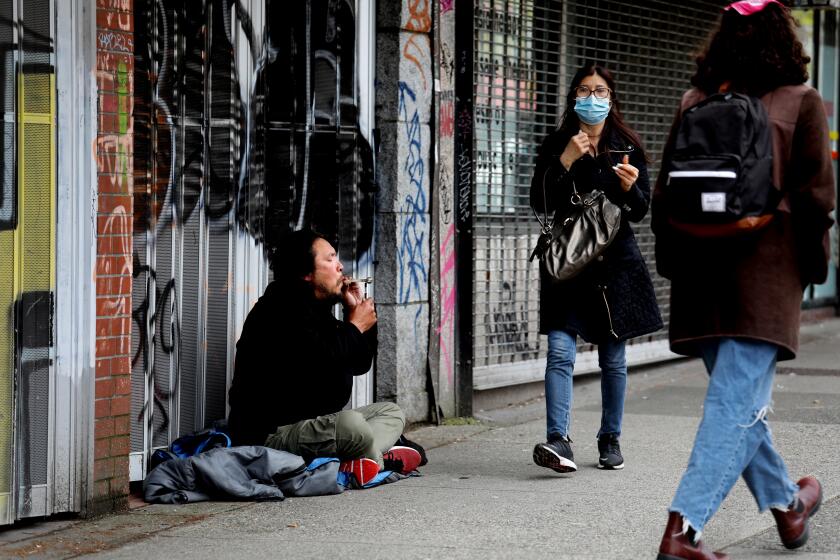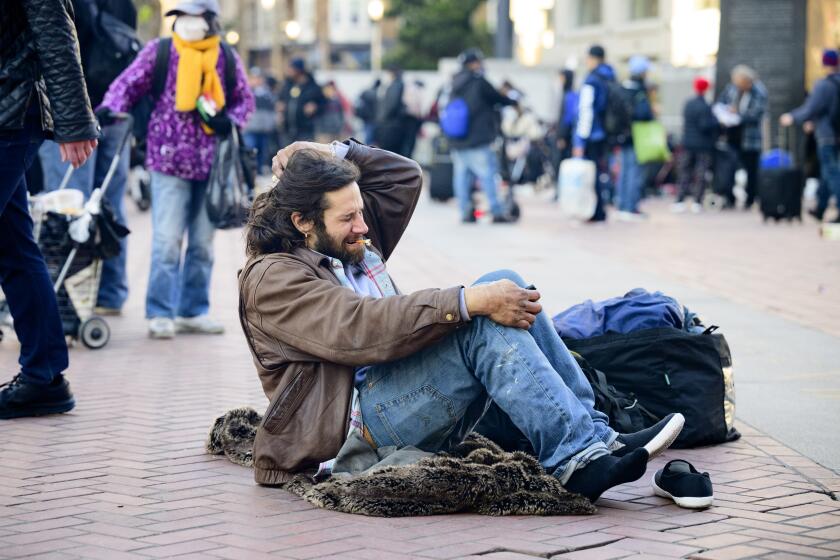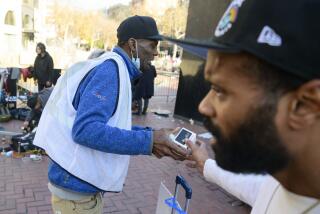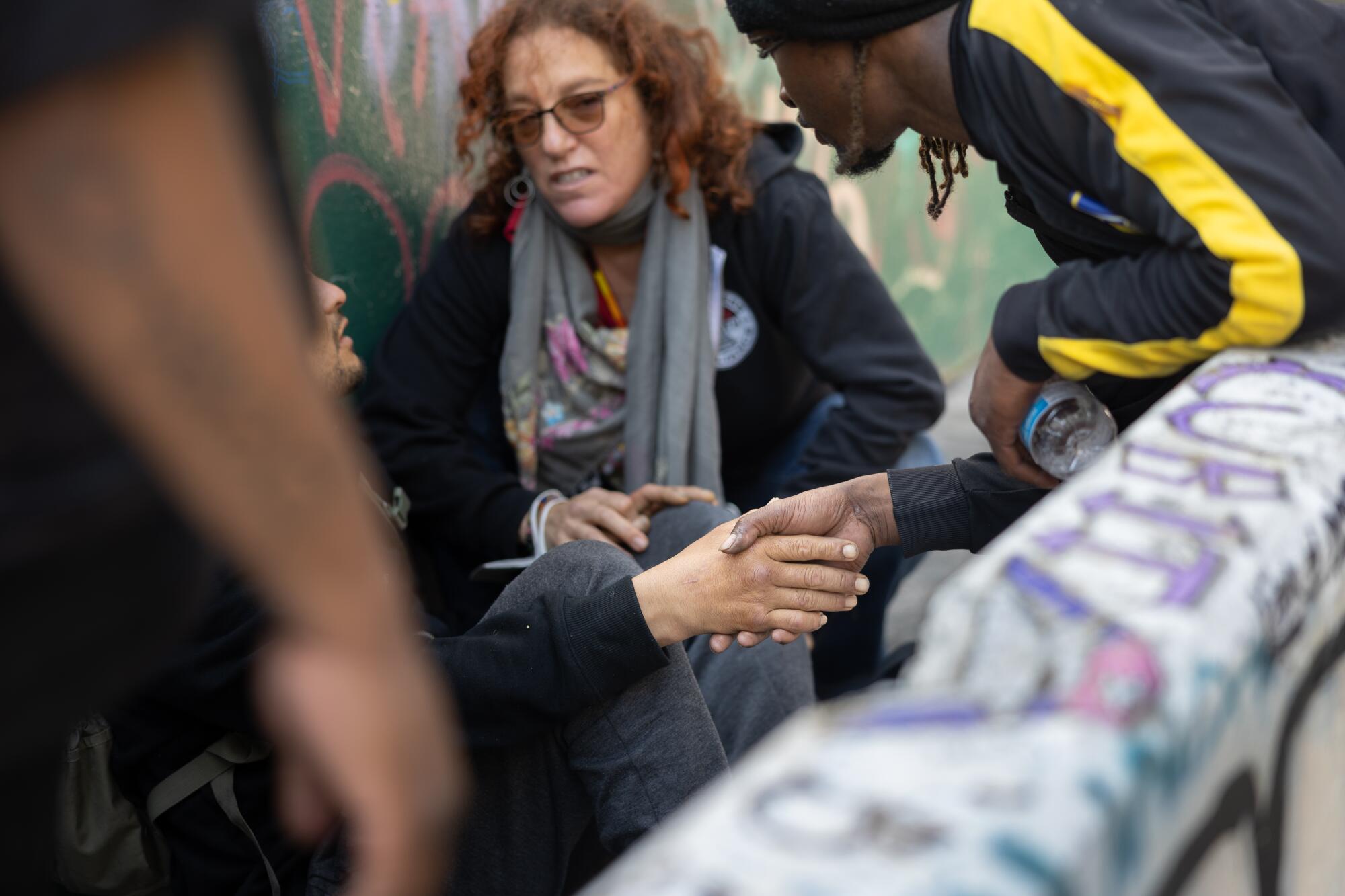
- Share via
SAN FRANCISCO — Isaias Lopez was dying, but he didn’t know it.
Lopez was slumped against a wall in the Tenderloin district of San Francisco, where the concentration of homelessness and drug use have divided this city politically.
A baby blue baseball cap and a white hoodie covered his head, making him just another human lump to be avoided by passersby. He had begun to nod off from the fentanyl that minutes ago was in a scrap of tin foil that now lay nearly empty on his legs.
Lopez’s oxygen saturation level had fallen to 87%, according to a thumb monitor that aid workers from a nearby illegally run safe consumption site had slipped on him; he was in danger of passing out and never waking up. They roused him as best they could, then put an oxygen mask on him, likely saving his life.
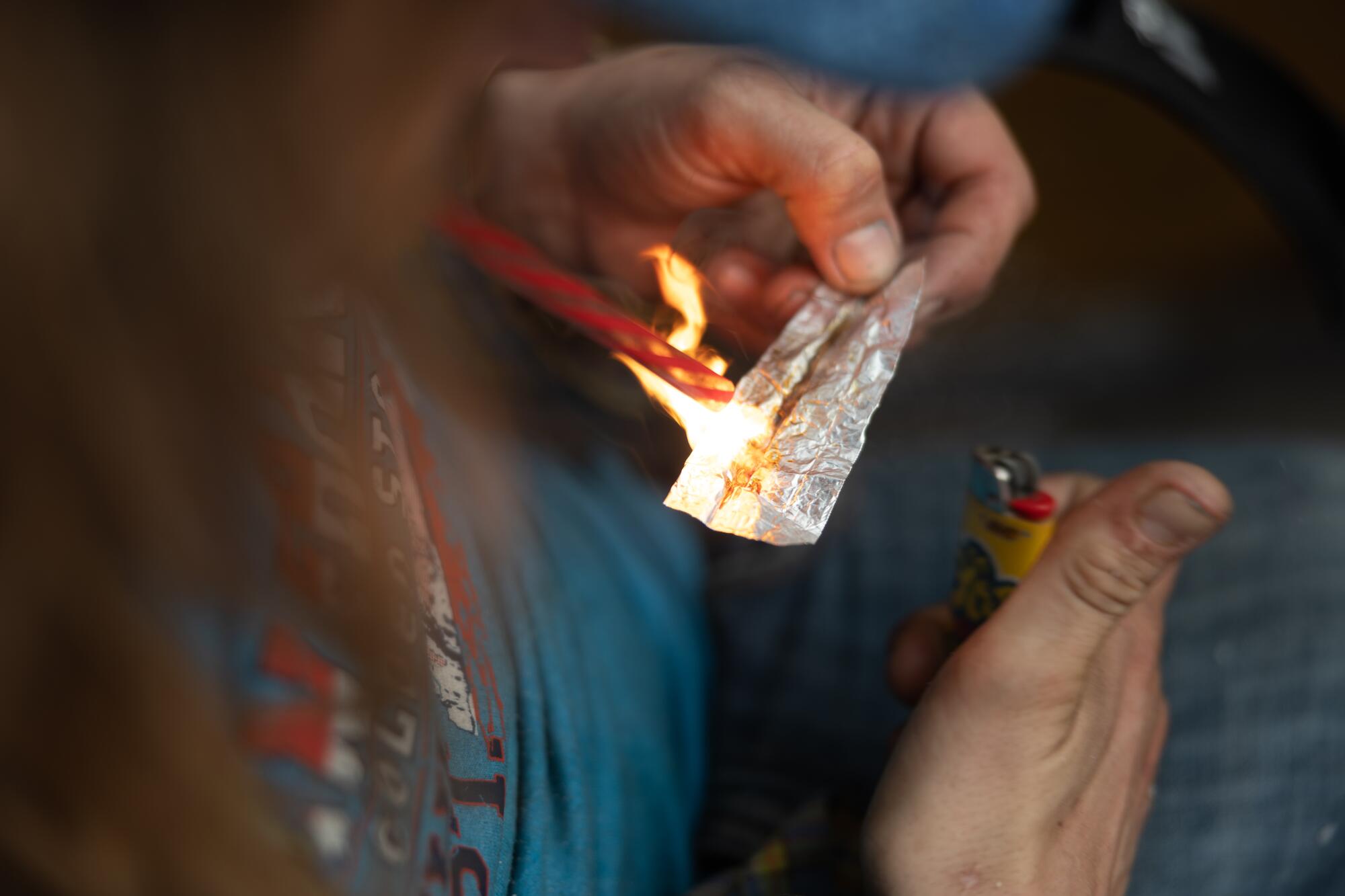
Minutes earlier, I stood less than a block away as a Latino man I’ll call E. almost died from another fentanyl overdose. E. was behind a concrete barrier on the sidewalk, his breathing stopped but his heart still beating. The same aid workers, from the same illegal overdose prevention operation, rubbed his chest. The oxygen mask went on. Two doses of Narcan later, he was up and walking away.
“Just another day around here,” said E.’s friend Jabari M., who had run for the Narcan when he realized what was happening. He asked that I not use his full name because of the stigma of being on the streets.
Two lives saved before lunch — by rogue activists breaking the law to do it.
“Saving lives is an act of civil disobedience,” Lydia Bransten, one of those illicit do-gooders, told me. “Insane.”
In a city where more than 470 people have already died of overdoses this year, putting it on track to be the most deadly year for drug deaths on record, I have to disagree.
Keeping overdose prevention sites illegal isn’t insane, implying a lack of control over the situation. It’s cruel, to those addicted and those that care about them — a move that puts optics and politics over lives.
But that’s the political decision that has been made by President Biden, seconded by Gov. Gavin Newsom and now left for mayors, such as San Francisco’s London Breed, to sort out. I’ll explain that in a minute.
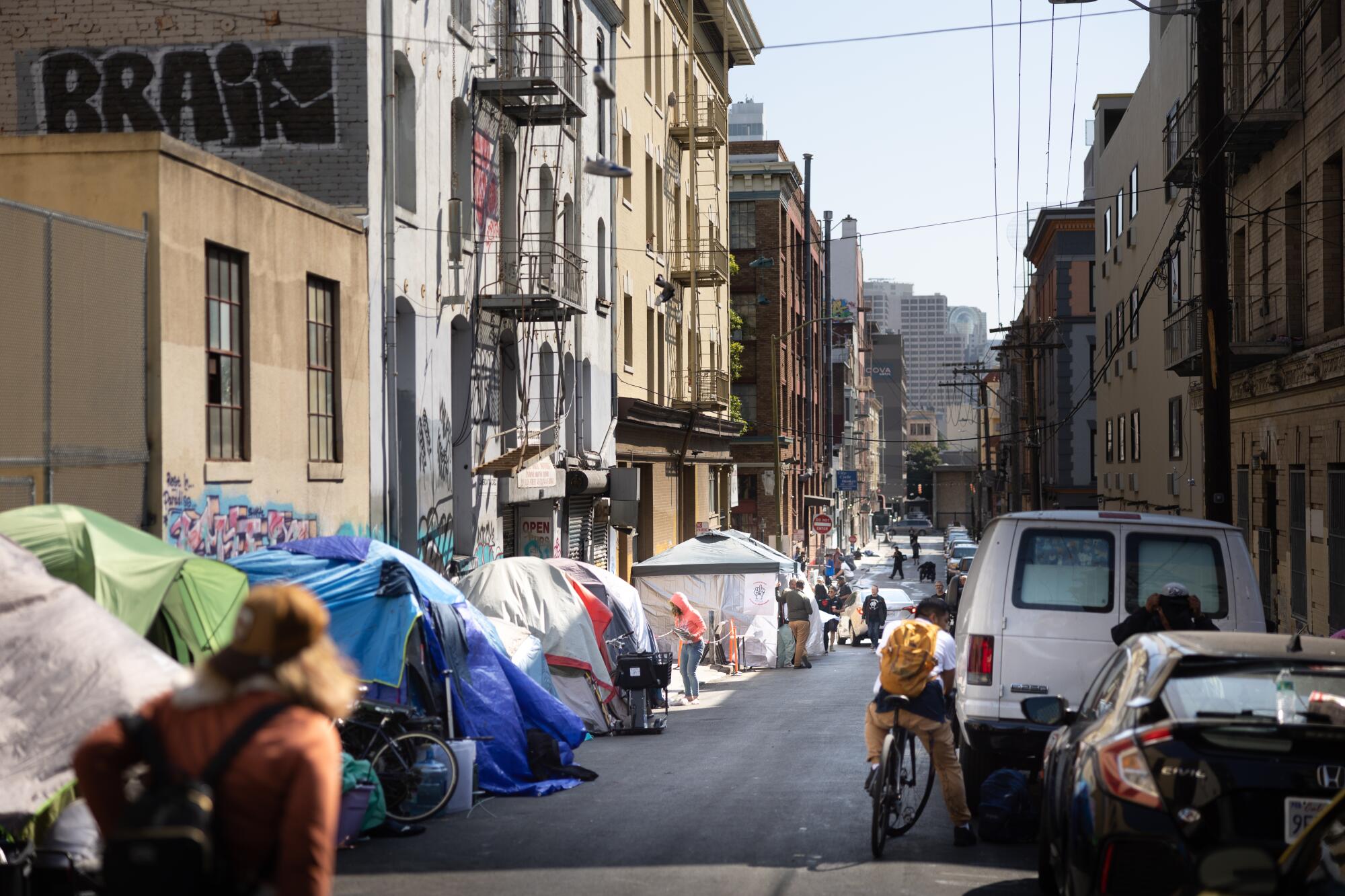
The overdoses I witnessed happened on Willow Street in the Tenderloin. Fed-up activists, many with city-related or nonprofit day jobs, had taken time off to create an illegal safe drug consumption site under two gray pop-up tents here, with “the war against us,” scrawled in colored chalk on the road.
A half-dozen people smoked mostly fentanyl inside one, while intravenous drug users injected in the other — all under the watchful eyes of staff who know how to reverse an overdose.
It was a protest on International Overdose Awareness Day against the city’s inaction on creating permanent places where people can be monitored while they do drugs — sometimes called overdose prevention centers or safe consumption sites.
Such places sound extreme but are successfully running in New York City and have been used for decades in Vancouver and Europe. These centers protect the lives of people like Lopez and E., who would otherwise do drugs in dangerous situations.
But they are also meant to take drug use out of the public view, making streets safer and cleaner.
For years, this Canadian city has hosted safe consumption sites for addicts. They’ve saved lives, but with some painful tradeoffs.
This stretch of Willow Street has for years been home to tents and addiction, despite dozens of attempts by the city to sweep it clean. It represents the kind of frustration that has polarized this city and created an unexpected conservative backlash to harm reduction policies for drug users in recent months, especially those visibly living on the streets.
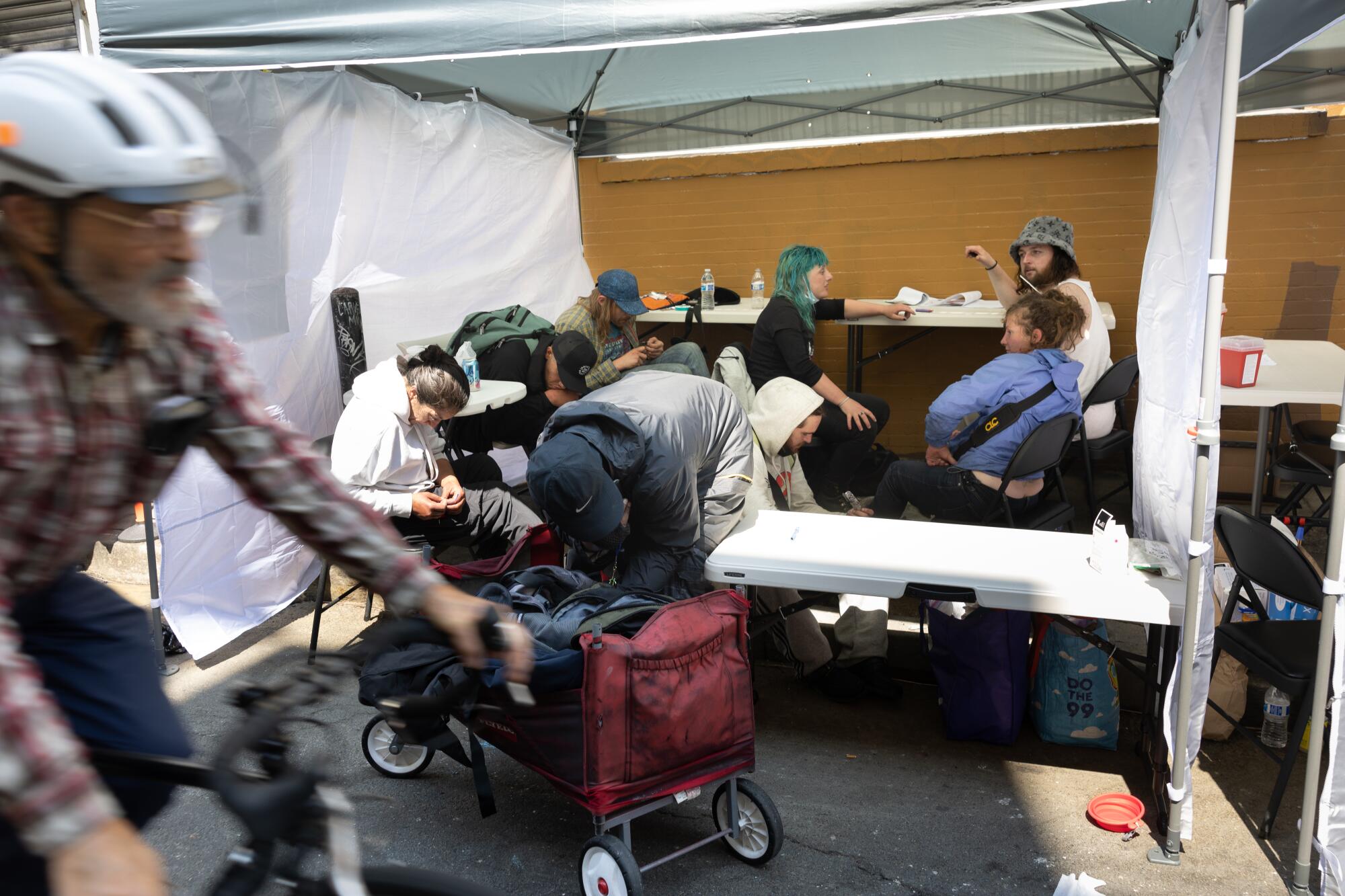
A few blocks from here, the city had until December allowed some of these same activists to run an overdose prevention site in a homeless services center, not necessarily condoning it but not stopping it. It was a don’t ask/don’t tell situation that sent the Fox News types into a spin.
The ensuing pressure caused the city to shut it down, promising to come up with a plan to open safe consumption sites in multiple neighborhoods.
But then, like so many places recently, the pendulum swung. San Francisco, once the undisputed champion of progressive politics in the Golden State and maybe the country, is over it.
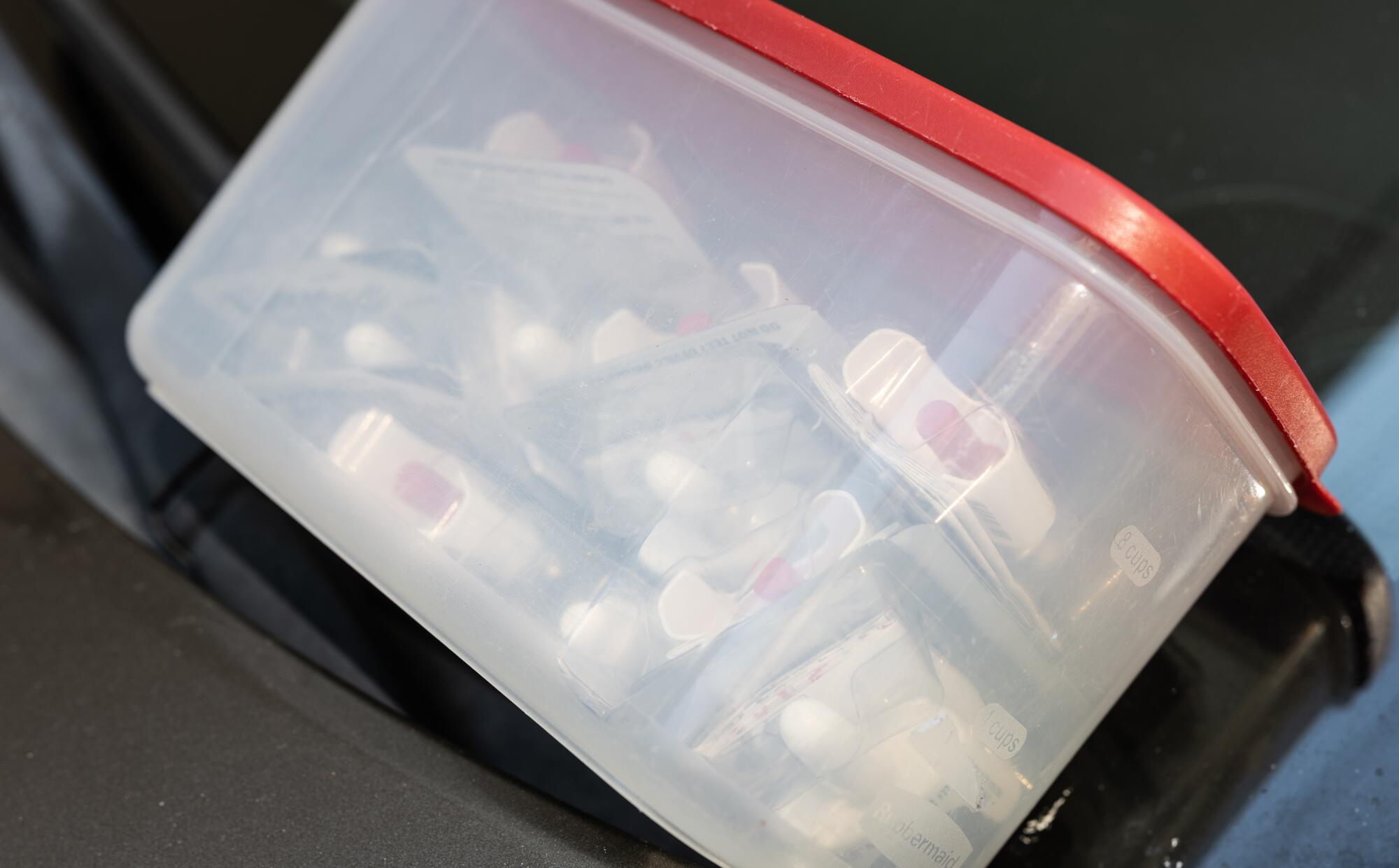
“This city is being taken advantage of, and we are tired of it,” Breed told a raucous crowd in front of a federal courthouse here last week, as she fought to lift a ban on sweeping homeless encampments.
In recent months, Breed and some city leaders have curved toward traditionally conservative policies on how drug addiction and homelessness should be addressed, championing efforts on multiple fronts to end open drug sales and consumption and clear streets largely through law enforcement tactics.
Under new policies, police are not only cracking down on open drug markets where dealers sell with impunity, but are threatening to arrest those using drugs. It’s a controversial move that hearkens to the failed tough-love days of the first “War on Drugs” that filled jails with Black and brown people who were — and still are — overrepresented in the ranks of incarceration, those facing addiction and homelessness.
One city supervisor, Matt Dorsey — a former spokesman for the Police Department and a former drug user — has even suggested cutting off money reserved to create “wellness hubs” around the city and instead dumping the millions into “jail-based recovery.”
When I spoke with Dorsey, he told me he supported safe consumption sites but didn’t see them as politically viable right now, especially in his district, which includes places where the drug problem is indisputably impeding the quality of life for housed and unhoused people alike.
“I had never seen the city as close to pitchforks and torches as I do now,” he told me.
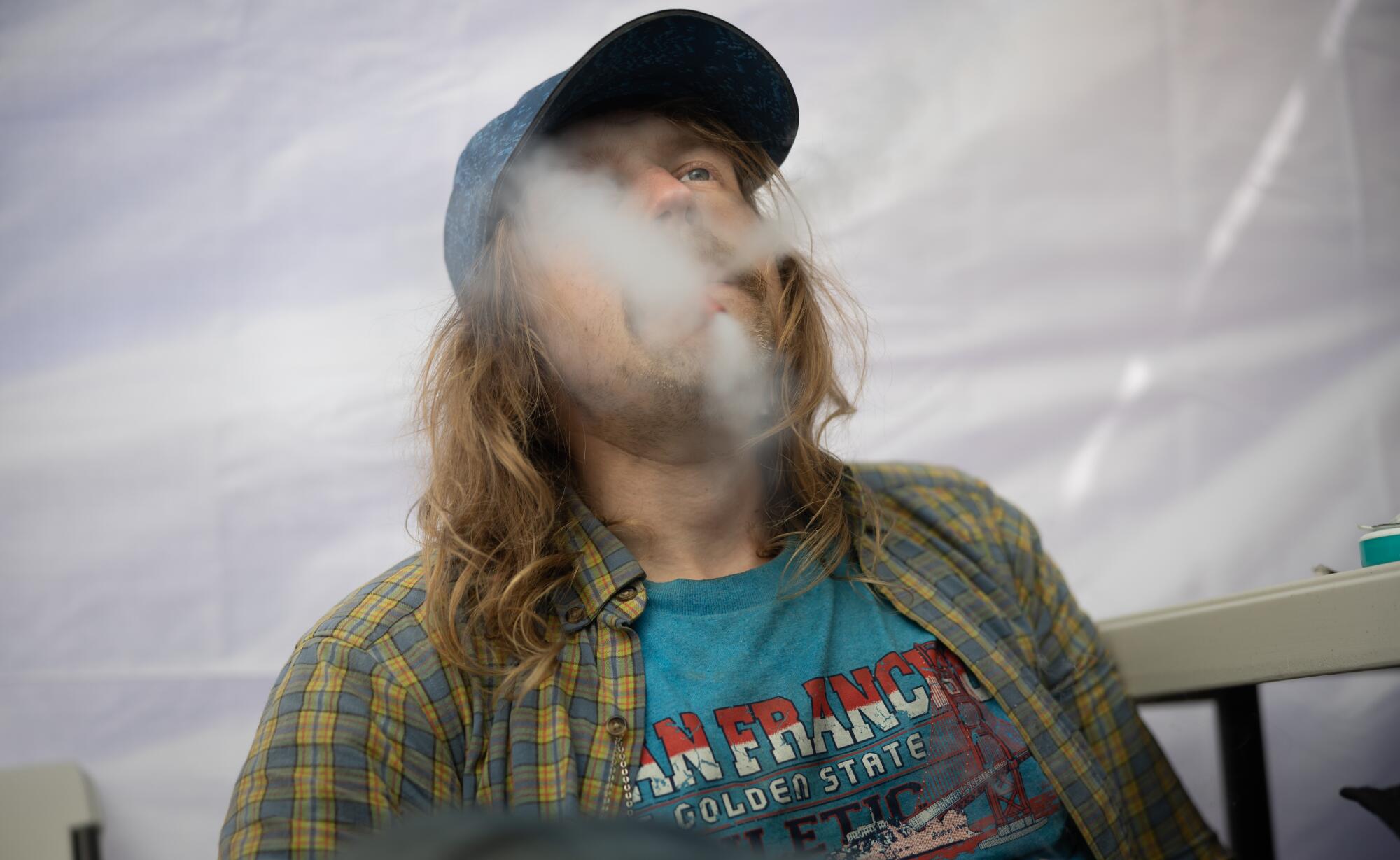
There’s a “fix it or we’ll find someone who can” mentality, he said, making it impossible for him to open a wellness hub in his district because people fear it would make the neighborhood worse. If there were multiple hubs open at once — all with safe consumption sites that could help alleviate the visible problem — then he would support them, he said.
Column: Overdose prevention reaches a critical crossroad in San Francisco. What will Mayor Breed do?
San Francisco opened a semi-legal safe drug consumption site, then shut it months later with no real plans for another, as the fentanyl crisis grows.
But here is where it gets complicated and Biden and Newsom come into the mix.
Safe consumption sites are illegal under a federal law known as the “crack house statute,” which basically makes it a serious crime to open or maintain any building for the purpose of using a controlled substance. That law was put in place as part of the Anti-Drug Abuse Act of 1986, meant to address — you guessed it — crack houses.
A nonprofit in Philadelphia has litigated with the federal government in multiple cases in a bid to change or at least curb that law. For a while, it looked like Biden’s Department of Justice was going to work out a compromise, taking away the risk of criminal prosecution for those who run overdose prevention centers.
But the talks have gone nowhere and the case continues to wind through the courts, leaving a real risk of criminal and civil liability for states, cities and nonprofits — and even the staff who would work in such centers — who feel compelled to do anything and everything to save lives during this national epidemic of drug deaths.
“I would expect this in a Trump administration. I wouldn’t expect this in a Biden administration,” Dorsey said. He doesn’t see Biden addressing the issue unless he wins a second term.
Newsom had a chance last year to allow California to take on the brunt of the liability, but he punted.
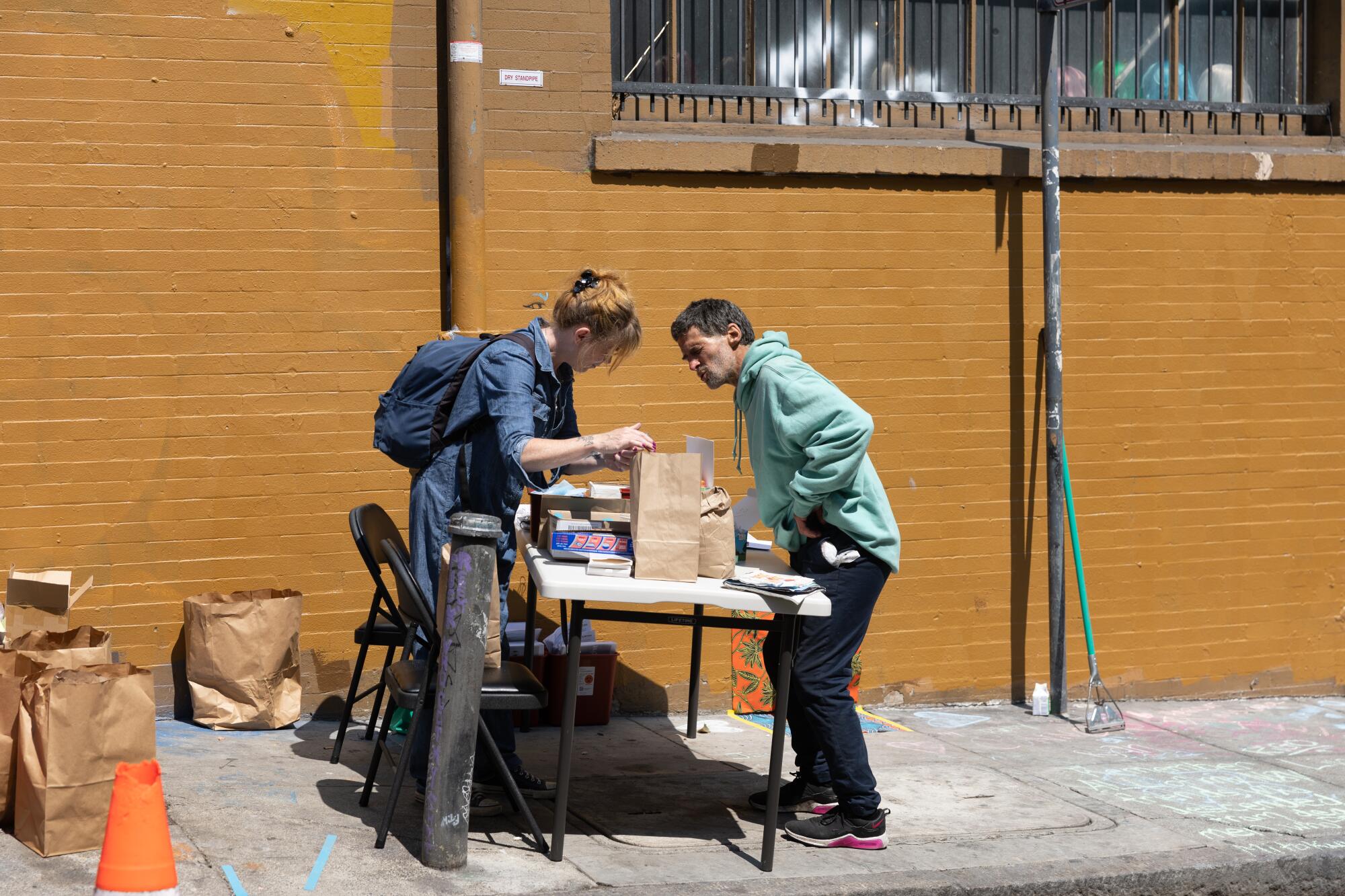
Legislators passed a bill that would have allowed pilot programs in San Francisco, Los Angeles and a couple of other places to open overdose prevention centers. Newsom vetoed the bill, citing a fear of unintended consequences. He kicked the issue to the Department of Health and Human Services for further study.
As far as I was able to determine, it has held one virtual meeting, done some site visits and quiet-buried the whole thing.
To be fair, Newsom has invested heavily in other ways to combat the fentanyl crisis — more than $150 million for naloxone distribution, $61 million for other types of harm reduction, $30 million to develop a generic version of Narcan. All good stuff.
But his latest plan, released in March, makes no mention of overdose prevention sites.
That leaves the whole mess in local hands — Breed’s to be specific. Her office didn’t return my call, but she’s said in the past she supports safe consumption sites.
If.
If the liability issue can be worked out. Which it really can’t unless the federal or state government steps in.
So back to the activists, who aren’t willing to wait. And back to those with addictions, many of whom hate the idea that their disease — yes, addiction is a medically treatable condition — is making life untenable for those around them.
Jamal Wilson feels that way. He came to the pop-up on Thursday to smoke fentanyl in a place that was safe and out of the way. He’s from South Los Angeles and moved up here because the fetty, as he calls it, was cheaper. Folks up here call him L.A.
Wilson didn’t start using drugs until two painful back surgeries at the age of 36. Until then, he’d been just a regular father with a college degree in political science and child development, the kind of guy who loved to roll around on the grass with his two kids and pretend to be “Star Wars” characters.
But a nearly unlimited prescription for OxyContin got him hooked. Soon, he was crushing the pills and snorting them. Then he turned to street drugs. Ten years later, here he is.
“Fentanyl makes you turn your back on the ones you love the most,” he told me, thinking of those kids. He believes he will some day get this addiction under control, though he says he feels so far away from his old life that he can’t see the path.
“I am still a person,” he told me. “When you shun us, you forget we are someone’s son or daughter.”
And that’s really all of it. If any of the people on this street were my kids, I would hope there was a Lydia Bransten around to save their life, to give them a place of safety, respite and respect in the hopes it allowed them to see a path back to their old life.
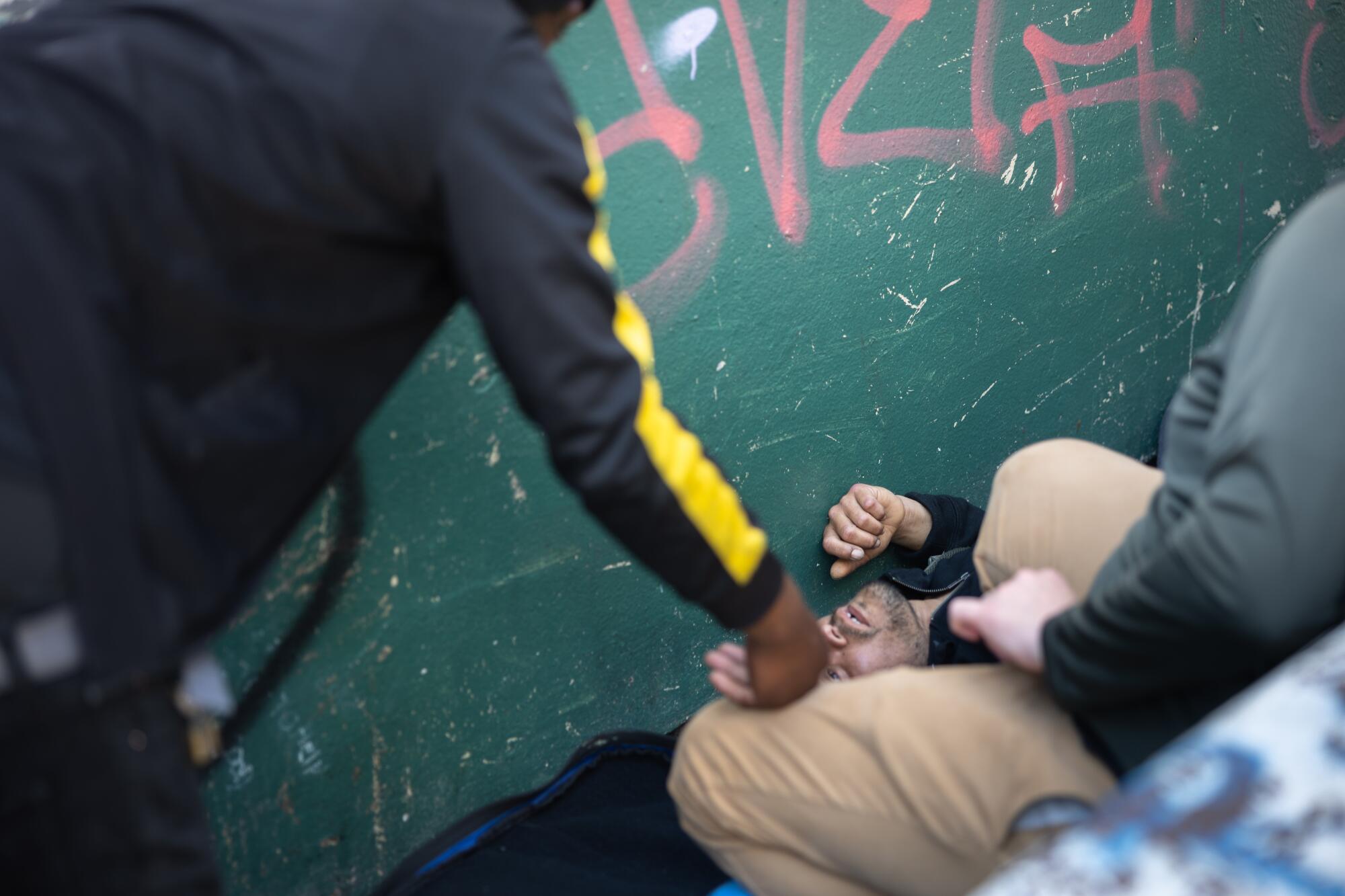
When I talked to Jabari after E. overdosed, he told me E. was “a person anyone would want as a friend,” smart and funny.
And though Jabari had saved a life, he didn’t see himself as any kind of hero.
“My mom and dad would kill me if I didn’t do something to be the change,” he told me as his dog Mia lapped up the remains of a carton of strawberry cream cheese.
Someone’s son.
Of course our drug crisis is complicated and hard to understand — and often ugly. When I found Lopez, the other man who overdosed, around the corner, he told me it was all a mistake — the aid workers had been confused and he didn’t need help.
“I’m good,” Lopez, an immigrant from Guatemala who has lived on the streets for six years, told me as he searched for a lighter to smoke the tiny nugget of fentanyl remaining on his crumpled tin foil.
I walked him back to the safe consumption site, worried smoking again so soon wasn’t the best idea. I didn’t want to leave this stretch of misery thinking he would just sit down against another wall and die, unnoticed.
That’s the most terrifying part of a fentanyl overdose, how truly uneventful it is and how easy to miss if no one is watching.
But also a death easy to avoid, if someone is.
More to Read
Sign up for Essential California
The most important California stories and recommendations in your inbox every morning.
You may occasionally receive promotional content from the Los Angeles Times.
